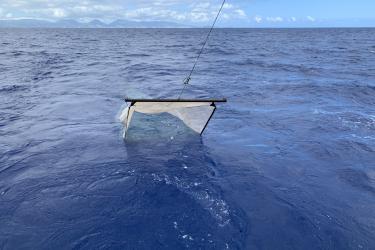Pearl and Hermes Atoll, Holoikauaua in Hawaiian, is located 1,299 miles northwest of Honolulu. It is home to immense biodiversity, shipwrecks, and an unfortunate amount of derelict fishing gear and other marine debris. The interior of the atoll is described as “the maze” for its shallow vein-like coral structure, which makes navigation challenging. This atoll was one of my favorite places we visited throughout the entire Monument. It is full of life and indescribably beautiful, with sparkling clear water tinted with every shade of blue imaginable.
Back in 2016, scientists discovered a new and potentially invasive algae at Pearl and Hermes, named Chondria tumulosa. This algae is known for its ability to smother and kill coral reefs, a similar trait to derelict fishing nets. With this in mind, we avoided debris with the invasive algae on or around it. The team was taught how to identify this invasive algae and only collected debris after thoroughly examining the net and surrounding area and confirming none was present. We followed very strict bleaching protocols for the debris (nets), small boats, ship, dive and removal gear to ensure we eliminated any traces of the invasive algae. We stored all of the nets collected from Pearl and Hermes Atoll in a water-tight 20-foot industrial shipping container filled with a highly concentrated bleach solution.
Over six days the marine debris team removed a whopping 23,650 pounds of debris from Pearl and Hermes Atoll. They conducted in-water debris removal operations on the first day. The NOAA Protected Species Division Hawaiian Monk Seal Research Program remote field camp team, who was stationed at Pearl and Hermes Atoll, had located and marked large derelict fishing nets for our team to remove upon arrival. Most of these massive nets required two boats, serious muscle, and creative rope arrays, such as the “parbuckle,” to haul them up. After just one day, we completely filled the 20-foot shipping container with nets removed from the reefs and were then restricted to removing dry, shoreline debris for the remainder of our mission.
On day two, we focused on a research project started in 2018, which studied the negative impacts of derelict fishing nets on coral reefs. We documented the successional changes that occurred on the reef after net removal, using Structure-from-Motion photogrammetry surveys. Structure-from-Motion stitches hundreds of 2-dimensional photographs captured in the field into a highly detailed, 3-dimensional model. Our goal was to compare hard coral growth (or recovery) at impact sites (after net removal) versus nearby control sites and determine if net removal had benefited the coral reefs. Photos were initially taken in 2018 at the net impact site before and after net removal. In 2021, we took photos of the net impact and control sites. We will compare the 2018 and 2021 Structure-from-Motion models to determine the rate of coral reef growth. This day of surveying was extremely fun and was a nice break for our aching backs and muscles!
We spent the rest of our time at the atoll removing shoreline debris from the eight islands at Pearl and Hermes (Seal, Kittery, Grass, Little Grass, Bird, Southeast, North, Little North Islands). We removed a plethora of nets, part of an old shipping container, and even a Japanese panga boat! On our last day, a pod of resident spinner dolphins escorted us from the ship outside the atoll through the channel towards the island where we continued our work. As the dolphins breached the water, spinning and flipping, they seemed to be thanking us for all of our hard work. It was a magical moment and the perfect way to end the trip. Pearl and Hermes is truly a powerful place, and I feel so honored that we were able to positively impact the life that calls this place home.










